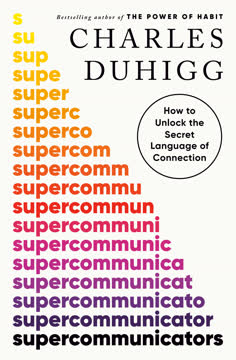Key Takeaways
1. Unspoken Information Hinders Relationships and Progress
When we fail to recognize and overcome the barriers that lead the people around us to hold back, we miss out on enormous learning and insights, which are right there in front of our noses!
The Unspoken Problem. People often withhold important thoughts, feelings, and ideas, creating an "invisible problem" that hinders relationships and progress. This unspoken information, residing in what's called the "left-hand column," represents a gold mine of insights that remain untapped. This can lead to missed opportunities, poor decisions, and strained relationships.
Real-world consequences. The lack of open communication can have significant consequences in various settings. For example, a manager may be unaware of a team member's struggles, leading to missed deadlines and decreased morale. Similarly, a doctor may fail to discover a patient's concerns about medication side effects, resulting in non-compliance and adverse health outcomes.
Overcoming the challenge. By recognizing the value of unspoken information and actively working to overcome the barriers that prevent people from sharing, we can unlock new possibilities for learning, growth, and connection. The Ask Approach provides a framework for fostering open communication and tapping into the hidden wisdom of those around us.
2. Four Barriers Prevent Open Communication
Why don’t people tell you what’s most important for you to find out?
Impact of Sharing. People often worry about the potential negative consequences of sharing their true thoughts and feelings. This includes concerns about hurting or upsetting others, facing judgment or punishment, or damaging relationships. These fears can be especially pronounced in situations involving power imbalances or cultural differences.
Inability to Articulate. Another barrier is the difficulty in finding the right words to express complex or sensitive ideas. This can stem from a lack of communication skills, a fear of being misunderstood, or the feeling that their words won't be accepted or valued. Sometimes, people are still processing their thoughts and feelings and need time to formulate a coherent message.
Lack of Time or Energy. The demands of modern life often leave people feeling overwhelmed and depleted, making it difficult to invest the time and energy required for open communication. This can be exacerbated by stress, burnout, or the emotional exhaustion of dealing with discrimination or bias.
Perceived Lack of Value. People may withhold information if they believe their input isn't valued or that their concerns won't be taken seriously. This can be based on past experiences, cultural norms, or a general sense that their voice doesn't matter.
3. Choose Curiosity to Unlock New Perspectives
Intentionally looking for new information and different ways of understanding people, situations, and the world around you.
Connective Curiosity. Curiosity is a powerful driver for learning and connection. Connective curiosity, in particular, is the desire to understand the thoughts, experiences, and feelings of others. This type of curiosity not only benefits the asker but also validates the sharer, making them feel heard and valued.
The Ladder of Understanding. The ladder of understanding is a tool for unpacking our own thinking and identifying areas where we can inject curiosity. It involves recognizing that our perceptions are shaped by our experiences and biases and actively seeking out alternative perspectives.
Overcoming Certainty. By choosing curiosity, we can interrupt the "certainty loop" and open ourselves to new information and different ways of understanding the world. This requires a willingness to challenge our assumptions, embrace ambiguity, and approach others with a genuine desire to learn.
4. Create Psychological Safety for Honest Sharing
Ensuring that it’s as comfortable, easy, and appealing as possible for others to share openly with you.
Psychological Safety. Psychological safety is essential for fostering open communication and learning. It refers to an environment where people feel safe to speak up, share their ideas, and admit mistakes without fear of judgment or punishment.
The Safety Cycle. The safety cycle involves creating connection, opening up, and radiating resilience. This includes building trust, demonstrating vulnerability, and showing that you can handle difficult information.
Practical Strategies. To create psychological safety, it's important to find the right space and time for conversations, use a communication style that is comfortable for the other person, and be transparent about your intentions. It also involves actively listening, validating their feelings, and showing that you value their input.
5. Quality Questions Elicit Valuable Insights
Quality questions help us learn something important from the person we ask.
Beyond Crummy Questions. Not all questions are created equal. Clumsy, sneaky, and attack questions can shut down communication and prevent learning. Quality questions, on the other hand, are designed to elicit valuable insights and foster deeper understanding.
Attributes of Quality Questions. Quality questions signal true curiosity, are clear and direct, invite honesty, tap into the other person's full story, and create mutual benefit. They are designed to learn, not to influence or manipulate.
Walking Down Their Ladder. To truly understand someone's perspective, it's important to walk down their ladder of understanding. This involves hearing their headline, digging deeper into their reasoning, and seeing what they see by exploring their experiences and data points.
6. Listen Intentionally to Understand Fully
Intentionally opening ourselves to all that another person shares, in order to understand what’s essential about their message and experience.
Listening with Intention. Listening to learn requires a conscious effort to open ourselves to all that another person shares, with the goal of understanding their message and experience. This is distinct from listening to prove a point, offer advice, or simply appear to be a good listener.
Three Channels of Listening. Effective listening involves tuning into three channels: content, emotion, and action. This means paying attention not only to the facts and claims being made but also to the underlying feelings and intentions.
Practical Strategies. To improve your listening skills, it's important to ditch distractions, zip your lip, watch your face, paraphrase and test, pull the thread, back off to move forward, and check in. These practices can help you create a safe and supportive environment for open communication.
7. Reflect and Reconnect to Turn Talk into Action
The hardest part of learning from others isn’t asking the questions, or even listening to the answers. It’s deciding what to do with what we hear.
The Importance of Reflection. Reflection is essential for making meaning of the information we receive and translating it into actionable insights. It involves sifting through what we've heard, identifying key themes, and considering how it affects our own thinking and behavior.
The Three Turns. The three turns are a structured set of questions to guide the reflection process: reflect on your story, reflect on your steps, and reflect on your stuff. This helps us to challenge our assumptions, identify new courses of action, and explore our deeper worldviews.
The Power of Reconnecting. Once we've reflected, it's important to reconnect with the person who shared their insights and let them know what we've learned. This demonstrates that we value their input and reinforces open communication. It also provides an opportunity to clarify any misunderstandings and build stronger relationships.
8. Mastery of Asking Requires Continuous Practice
About as long as it takes to learn how to play a half-decent game of tennis.
The Mastery Spiral. Building any superpower, including the ability to ask and learn effectively, requires continuous practice and refinement. The mastery spiral involves moving through stages of unconscious incompetence, conscious incompetence, conscious competence, and unconscious competence.
From Incompetence to Competence. The journey begins with recognizing our own incompetence and identifying areas for improvement. As we learn and practice new skills, we move towards conscious competence, where we can perform the skills with effort and concentration.
Deliberate Practice and Feedback. With enough practice and feedback, we can internalize the skills and reach unconscious competence, where they become natural and habitual. This requires a commitment to ongoing learning and a willingness to seek out new challenges.
9. Organizations Thrive by Tapping Collective Genius
It is through organizations that we innovate, respond to macro-challenges like market disruptions and climate change, and distribute precious social resources like aid and education.
Collective Genius. Organizations, like individuals, can benefit from the Ask Approach. By tapping into the collective genius of their stakeholders, they can make better decisions, foster innovation, and adapt to change more effectively.
Engaging Stakeholders. To tap into collective genius, organizations need to engage their end users, employees, and other key stakeholders in meaningful ways. This includes creating opportunities for open communication, soliciting feedback, and empowering people to share their ideas and experiences.
Building a Culture of Asking. Organizations can build a culture of asking by incorporating these skills into their people practices, leading learning cycles, and promoting leaders who model curiosity and humility. This creates an environment where learning is valued and everyone feels empowered to contribute.
10. Nurture Curiosity in the Next Generation
Children have never been very good at listening to their elders, but they have never failed to imitate them.
Born Curious. Children are born with a natural curiosity and a desire to learn. However, this curiosity can be squelched by negative experiences at home and in school.
Fostering Curiosity. To nurture curiosity in the next generation, it's important to kindle the flames of their natural curiosity, model the behavior you want to see, teach them the skill set, and help them experience immediate benefits. This includes creating opportunities for exploration, encouraging questions, and providing honest and thoughtful answers.
Creating Askable Adults. By becoming "askable adults," we can create safe and supportive relationships with young people, where they feel comfortable sharing their thoughts, feelings, and experiences. This can help them develop a lifelong love of learning and a commitment to making a positive impact on the world.
Last updated:
Review Summary
Ask received mostly positive reviews, with readers praising its practical advice on improving communication and relationships. Many found the book's insights on asking better questions and listening deeply to be valuable. Some reviewers noted that the concepts weren't entirely new but appreciated the clear presentation and real-world examples. A few critics felt the book was repetitive or offered common-sense advice. Overall, readers found the book helpful for both personal and professional growth, with many recommending it as a useful guide for enhancing interpersonal skills.
Similar Books










Download PDF
Download EPUB
.epub digital book format is ideal for reading ebooks on phones, tablets, and e-readers.




